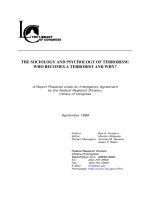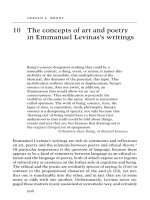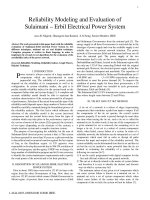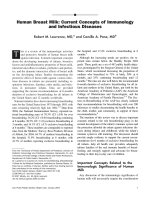Themes and Concepts of Biology
Bạn đang xem bản rút gọn của tài liệu. Xem và tải ngay bản đầy đủ của tài liệu tại đây (4.89 MB, 16 trang )
Themes and Concepts of Biology
Themes and Concepts of
Biology
Bởi:
OpenStaxCollege
Biology is the science that studies life, but what exactly is life? This may sound like
a silly question with an obvious response, but it is not always easy to define life. For
example, a branch of biology called virology studies viruses, which exhibit some of
the characteristics of living entities but lack others. It turns out that although viruses
can attack living organisms, cause diseases, and even reproduce, they do not meet the
criteria that biologists use to define life. Consequently, virologists are not biologists,
strictly speaking. Similarly, some biologists study the early molecular evolution that
gave rise to life; since the events that preceded life are not biological events, these
scientists are also excluded from biology in the strict sense of the term.
From its earliest beginnings, biology has wrestled with three questions: What are the
shared properties that make something “alive”? And once we know something is alive,
how do we find meaningful levels of organization in its structure? And, finally, when
faced with the remarkable diversity of life, how do we organize the different kinds of
organisms so that we can better understand them? As new organisms are discovered
every day, biologists continue to seek answers to these and other questions.
Properties of Life
All living organisms share several key characteristics or functions: order, sensitivity
or response to the environment, reproduction, growth and development, regulation,
homeostasis, and energy processing. When viewed together, these eight characteristics
serve to define life.
1/16
Themes and Concepts of Biology
Order
A toad represents a highly organized structure consisting of cells, tissues, organs, and organ
systems. (credit: “Ivengo”/Wikimedia Commons)
Organisms are highly organized, coordinated structures that consist of one or more cells.
Even very simple, single-celled organisms are remarkably complex: inside each cell,
atoms make up molecules; these in turn make up cell organelles and other cellular
inclusions. In multicellular organisms ([link]), similar cells form tissues. Tissues, in
turn, collaborate to create organs (body structures with a distinct function). Organs work
together to form organ systems.
Sensitivity or Response to Stimuli
The leaves of this sensitive plant (Mimosa pudica) will instantly droop and fold when touched.
After a few minutes, the plant returns to normal. (credit: Alex Lomas)
Organisms respond to diverse stimuli. For example, plants can grow toward a source
of light, climb on fences and walls, or respond to touch ([link]). Even tiny bacteria
can move toward or away from chemicals (a process called chemotaxis) or light
(phototaxis). Movement toward a stimulus is considered a positive response, while
movement away from a stimulus is considered a negative response.
2/16
Themes and Concepts of Biology
Link to Learning
Watch this video to see how plants respond to a stimulus—from opening to light, to
wrapping a tendril around a branch, to capturing prey.
Reproduction
Single-celled organisms reproduce by first duplicating their DNA, and then dividing it
equally as the cell prepares to divide to form two new cells. Multicellular organisms
often produce specialized reproductive germline cells that will form new individuals.
When reproduction occurs, genes containing DNA are passed along to an organism’s
offspring. These genes ensure that the offspring will belong to the same species and will
have similar characteristics, such as size and shape.
Growth and Development
All organisms grow and develop following specific instructions coded for by their
genes. These genes provide instructions that will direct cellular growth and
development, ensuring that a species’ young ([link]) will grow up to exhibit many of the
same characteristics as its parents.
Although no two look alike, these kittens have inherited genes from both parents and share many
of the same characteristics. (credit: Rocky Mountain Feline Rescue)
Regulation
Even the smallest organisms are complex and require multiple regulatory mechanisms to
coordinate internal functions, respond to stimuli, and cope with environmental stresses.
3/16
Themes and Concepts of Biology
Two examples of internal functions regulated in an organism are nutrient transport and
blood flow. Organs (groups of tissues working together) perform specific functions,
such as carrying oxygen throughout the body, removing wastes, delivering nutrients to
every cell, and cooling the body.
Homeostasis
Polar bears (Ursus maritimus) and other mammals living in ice-covered regions maintain their
body temperature by generating heat and reducing heat loss through thick fur and a dense layer
of fat under their skin. (credit: “longhorndave”/Flickr)
In order to function properly, cells need to have appropriate conditions such as proper
temperature, pH, and appropriate concentration of diverse chemicals. These conditions
may, however, change from one moment to the next. Organisms are able to maintain
internal conditions within a narrow range almost constantly, despite environmental
changes, through homeostasis (literally, “steady state”)—the ability of an organism to
maintain constant internal conditions. For example, an organism needs to regulate body
temperature through a process known as thermoregulation. Organisms that live in cold
climates, such as the polar bear ([link]), have body structures that help them withstand
low temperatures and conserve body heat. Structures that aid in this type of insulation
include fur, feathers, blubber, and fat. In hot climates, organisms have methods (such as
perspiration in humans or panting in dogs) that help them to shed excess body heat.
4/16
Themes and Concepts of Biology
Energy Processing
The California condor (Gymnogyps californianus) uses chemical energy derived from food to
power flight. California condors are an endangered species; this bird has a wing tag that helps
biologists identify the individual. (credit: Pacific Southwest Region U.S. Fish and Wildlife
Service)
All organisms use a source of energy for their metabolic activities. Some organisms
capture energy from the sun and convert it into chemical energy in food; others use
chemical energy in molecules they take in as food ([link]).
Levels of Organization of Living Things
Living things are highly organized and structured, following a hierarchy that can be
examined on a scale from small to large. The atom is the smallest and most fundamental
unit of matter. It consists of a nucleus surrounded by electrons. Atoms form molecules.
A molecule is a chemical structure consisting of at least two atoms held together
by one or more chemical bonds. Many molecules that are biologically important are
macromolecules, large molecules that are typically formed by polymerization (a
polymer is a large molecule that is made by combining smaller units called monomers,
which are simpler than macromolecules). An example of a macromolecule is
deoxyribonucleic acid (DNA) ([link]), which contains the instructions for the structure
and functioning of all living organisms.
5/16
Themes and Concepts of Biology
All molecules, including this DNA molecule, are composed of atoms. (credit:
“brian0918”/Wikimedia Commons)
Link to Learning
Watch this video that animates the three-dimensional structure of the DNA molecule
shown in [link].
Some cells contain aggregates of macromolecules surrounded by membranes; these
are called organelles. Organelles are small structures that exist within cells. Examples
of organelles include mitochondria and chloroplasts, which carry out indispensable
functions: mitochondria produce energy to power the cell, while chloroplasts enable
green plants to utilize the energy in sunlight to make sugars. All living things are made
of cells; the cell itself is the smallest fundamental unit of structure and function in living
6/16
Themes and Concepts of Biology
organisms. (This requirement is why viruses are not considered living: they are not
made of cells. To make new viruses, they have to invade and hijack the reproductive
mechanism of a living cell; only then can they obtain the materials they need to
reproduce.) Some organisms consist of a single cell and others are multicellular. Cells
are classified as prokaryotic or eukaryotic. Prokaryotes are single-celled or colonial
organisms that do not have membrane-bound nuclei; in contrast, the cells of eukaryotes
do have membrane-bound organelles and a membrane-bound nucleus.
In larger organisms, cells combine to make tissues, which are groups of similar cells
carrying out similar or related functions. Organs are collections of tissues grouped
together performing a common function. Organs are present not only in animals but also
in plants. An organ system is a higher level of organization that consists of functionally
related organs. Mammals have many organ systems. For instance, the circulatory system
transports blood through the body and to and from the lungs; it includes organs such as
the heart and blood vessels. Organisms are individual living entities. For example, each
tree in a forest is an organism. Single-celled prokaryotes and single-celled eukaryotes
are also considered organisms and are typically referred to as microorganisms.
All the individuals of a species living within a specific area are collectively called a
population. For example, a forest may include many pine trees. All of these pine trees
represent the population of pine trees in this forest. Different populations may live in the
same specific area. For example, the forest with the pine trees includes populations of
flowering plants and also insects and microbial populations. A community is the sum of
populations inhabiting a particular area. For instance, all of the trees, flowers, insects,
and other populations in a forest form the forest’s community. The forest itself is an
ecosystem. An ecosystem consists of all the living things in a particular area together
with the abiotic, non-living parts of that environment such as nitrogen in the soil or rain
water. At the highest level of organization ([link]), the biosphere is the collection of all
ecosystems, and it represents the zones of life on earth. It includes land, water, and even
the atmosphere to a certain extent.
Art Connection
7/16
Themes and Concepts of Biology
The biological levels of organization of living things are shown. From a single organelle to the
entire biosphere, living organisms are parts of a highly structured hierarchy. (credit
“organelles”: modification of work by Umberto Salvagnin; credit “cells”: modification of work
by Bruce Wetzel, Harry Schaefer/ National Cancer Institute; credit “tissues”: modification of
work by Kilbad; Fama Clamosa; Mikael Häggström; credit “organs”: modification of work by
Mariana Ruiz Villareal; credit “organisms”: modification of work by "Crystal"/Flickr; credit
“ecosystems”: modification of work by US Fish and Wildlife Service Headquarters; credit
“biosphere”: modification of work by NASA)
8/16
Themes and Concepts of Biology
Which of the following statements is false?
1.
2.
3.
4.
Tissues exist within organs which exist within organ systems.
Communities exist within populations which exist within ecosystems.
Organelles exist within cells which exist within tissues.
Communities exist within ecosystems which exist in the biosphere.
The Diversity of Life
The fact that biology, as a science, has such a broad scope has to do with the tremendous
diversity of life on earth. The source of this diversity is evolution, the process of gradual
change during which new species arise from older species. Evolutionary biologists study
the evolution of living things in everything from the microscopic world to ecosystems.
The evolution of various life forms on Earth can be summarized in a phylogenetic tree
([link]). A phylogenetic tree is a diagram showing the evolutionary relationships among
biological species based on similarities and differences in genetic or physical traits
or both. A phylogenetic tree is composed of nodes and branches. The internal nodes
represent ancestors and are points in evolution when, based on scientific evidence, an
ancestor is thought to have diverged to form two new species. The length of each branch
is proportional to the time elapsed since the split.
This phylogenetic tree was constructed by microbiologist Carl Woese using data obtained from
sequencing ribosomal RNA genes. The tree shows the separation of living organisms into three
domains: Bacteria, Archaea, and Eukarya. Bacteria and Archaea are prokaryotes, single-celled
organisms lacking intracellular organelles. (credit: Eric Gaba; NASA Astrobiology Institute)
Evolution Connection
9/16
Themes and Concepts of Biology
Carl Woese and the Phylogenetic TreeIn the past, biologists grouped living organisms
into five kingdoms: animals, plants, fungi, protists, and bacteria. The organizational
scheme was based mainly on physical features, as opposed to physiology, biochemistry,
or molecular biology, all of which are used by modern systematics. The pioneering work
of American microbiologist Carl Woese in the early 1970s has shown, however, that life
on Earth has evolved along three lineages, now called domains—Bacteria, Archaea, and
Eukarya. The first two are prokaryotic cells with microbes that lack membrane-enclosed
nuclei and organelles. The third domain contains the eukaryotes and includes unicellular
microorganisms together with the four original kingdoms (excluding bacteria). Woese
defined Archaea as a new domain, and this resulted in a new taxonomic tree ([link]).
Many organisms belonging to the Archaea domain live under extreme conditions and
are called extremophiles. To construct his tree, Woese used genetic relationships rather
than similarities based on morphology (shape).
Woese’s tree was constructed from comparative sequencing of the genes that are
universally distributed, present in every organism, and conserved (meaning that these
genes have remained essentially unchanged throughout evolution). Woese’s approach
was revolutionary because comparisons of physical features are insufficient to
differentiate between the prokaryotes that appear fairly similar in spite of their
tremendous biochemical diversity and genetic variability ([link]). The comparison of
homologous DNA and RNA sequences provided Woese with a sensitive device that
revealed the extensive variability of prokaryotes, and which justified the separation of
the prokaryotes into two domains: eubacteria and archaea.
10/16
Themes and Concepts of Biology
These images represent
different domains. The (a) bacteria in this micrograph belong to Domain Bacteria,
while the (b) extremophiles (not visible) living in this hot vent belong to Domain
Archaea. Both the (c) sunflower and (d) lion are part of Domain Eukarya. (credit a:
modification of work by Drew March; credit b: modification of work by Steve
Jurvetson; credit c: modification of work by Michael Arrighi; credit d: modification of
work by Leszek Leszcynski)
Branches of Biological Study
The scope of biology is broad and therefore contains many branches and subdisciplines.
Biologists may pursue one of those subdisciplines and work in a more focused field.
For instance, molecular biology and biochemistry study biological processes at the
molecular and chemical level, including interactions among molecules such as DNA,
RNA, and proteins, as well as the way they are regulated. Microbiology, the study of
microorganisms, is the study of the structure and function of single-celled organisms.
It is quite a broad branch itself, and depending on the subject of study, there are also
microbial physiologists, ecologists, and geneticists, among others.
Career Connection
Forensic ScientistForensic science is the application of science to answer questions
related to the law. Biologists as well as chemists and biochemists can be forensic
scientists. Forensic scientists provide scientific evidence for use in courts, and their job
11/16
Themes and Concepts of Biology
involves examining trace materials associated with crimes. Interest in forensic science
has increased in the last few years, possibly because of popular television shows that
feature forensic scientists on the job. Also, the development of molecular techniques
and the establishment of DNA databases have expanded the types of work that forensic
scientists can do. Their job activities are primarily related to crimes against people
such as murder, rape, and assault. Their work involves analyzing samples such as hair,
blood, and other body fluids and also processing DNA ([link]) found in many different
environments and materials. Forensic scientists also analyze other biological evidence
left at crime scenes, such as insect larvae or pollen grains. Students who want to pursue
careers in forensic science will most likely be required to take chemistry and biology
courses as well as some intensive math courses.
This forensic scientist works in a DNA extraction room at the U.S. Army Criminal Investigation
Laboratory at Fort Gillem, GA. (credit: United States Army CID Command Public Affairs)
Another field of biological study, neurobiology, studies the biology of the nervous
system, and although it is considered a branch of biology, it is also recognized as an
interdisciplinary field of study known as neuroscience. Because of its interdisciplinary
nature, this subdiscipline studies different functions of the nervous system using
molecular, cellular, developmental, medical, and computational approaches.
12/16
Themes and Concepts of Biology
Researchers work on excavating dinosaur fossils at a site in Castellón, Spain. (credit: Mario
Modesto)
Paleontology, another branch of biology, uses fossils to study life’s history ([link]).
Zoology and botany are the study of animals and plants, respectively. Biologists can
also specialize as biotechnologists, ecologists, or physiologists, to name just a few areas.
This is just a small sample of the many fields that biologists can pursue.
Biology is the culmination of the achievements of the natural sciences from their
inception to today. Excitingly, it is the cradle of emerging sciences, such as the biology
of brain activity, genetic engineering of custom organisms, and the biology of evolution
that uses the laboratory tools of molecular biology to retrace the earliest stages of life
on earth. A scan of news headlines—whether reporting on immunizations, a newly
discovered species, sports doping, or a genetically-modified food—demonstrates the
way biology is active in and important to our everyday world.
Section Summary
Biology is the science of life. All living organisms share several key properties such
as order, sensitivity or response to stimuli, reproduction, growth and development,
regulation, homeostasis, and energy processing. Living things are highly organized
parts of a hierarchy that includes atoms, molecules, organelles, cells, tissues, organs,
and organ systems. Organisms, in turn, are grouped as populations, communities,
ecosystems, and the biosphere. The great diversity of life today evolved from lessdiverse ancestral organisms over billions of years. A diagram called a phylogenetic tree
can be used to show evolutionary relationships among organisms.
Biology is very broad and includes many branches and subdisciplines. Examples include
molecular biology, microbiology, neurobiology, zoology, and botany, among others.
13/16
Themes and Concepts of Biology
Art Connections
[link] Which of the following statements is false?
1.
2.
3.
4.
Tissues exist within organs which exist within organ systems.
Communities exist within populations which exist within ecosystems.
Organelles exist within cells which exist within tissues.
Communities exist within ecosystems which exist in the biosphere.
[link] Communities exist within populations which exist within ecosystems.
Review Questions
The smallest unit of biological structure that meets the functional requirements of
“living” is the ________.
1.
2.
3.
4.
organ
organelle
cell
macromolecule
C
Viruses are not considered living because they ________.
1.
2.
3.
4.
are not made of cells
lack cell nuclei
do not contain DNA or RNA
cannot reproduce
A
The presence of a membrane-enclosed nucleus is a characteristic of ________.
1.
2.
3.
4.
prokaryotic cells
eukaryotic cells
living organisms
bacteria
B
A group of individuals of the same species living in the same area is called a(n)
________.
14/16
Themes and Concepts of Biology
1.
2.
3.
4.
family
community
population
ecosystem
C
Which of the following sequences represents the hierarchy of biological organization
from the most inclusive to the least complex level?
1.
2.
3.
4.
organelle, tissue, biosphere, ecosystem, population
organism, organ, tissue, organelle, molecule
organism, community, biosphere, molecule, tissue, organ
biosphere, ecosystem, community, population, organism
D
Where in a phylogenetic tree would you expect to find the organism that had evolved
most recently?
1.
2.
3.
4.
at the base
within the branches
at the nodes
at the branch tips
D
Free Response
Select two items that biologists agree are necessary in order to consider an organism
“alive.” For each, give an example of a non-living object that otherwise fits the
definition of “alive,”
Answers will vary. Layers of sedimentary rock have order but are not alive. Technology
is capable of regulation but is not, of itself, alive.
Consider the levels of organization of the biological world, and place each of these items
in order from smallest level of organization to most encompassing: skin cell, elephant,
water molecule, planet Earth, tropical rainforest, hydrogen atom, wolf pack, liver.
Smallest level of organization to largest: hydrogen atom, water molecule, skin cell, liver,
elephant, wolf pack, tropical rainforest, planet Earth
15/16
Themes and Concepts of Biology
You go for a long walk on a hot day. Give an example of a way in which homeostasis
keeps your body healthy.
During your walk, you may begin to perspire, which cools your body and helps your
body to maintain a constant internal temperature. You might also become thirsty and
pause long enough for a cool drink, which will help to restore the water lost during
perspiration.
Using examples, explain how biology can be studied from a microscopic approach to a
global approach.
Researchers can approach biology from the smallest to the largest, and everything
in between. For instance, an ecologist may study a population of individuals, the
population’s community, the community’s ecosystem, and the ecosystem’s part in the
biosphere. When studying an individual organism, a biologist could examine the cell
and its organelles, the tissues that the cells make up, the organs and their respective
organ systems, and the sum total—the organism itself.
16/16









